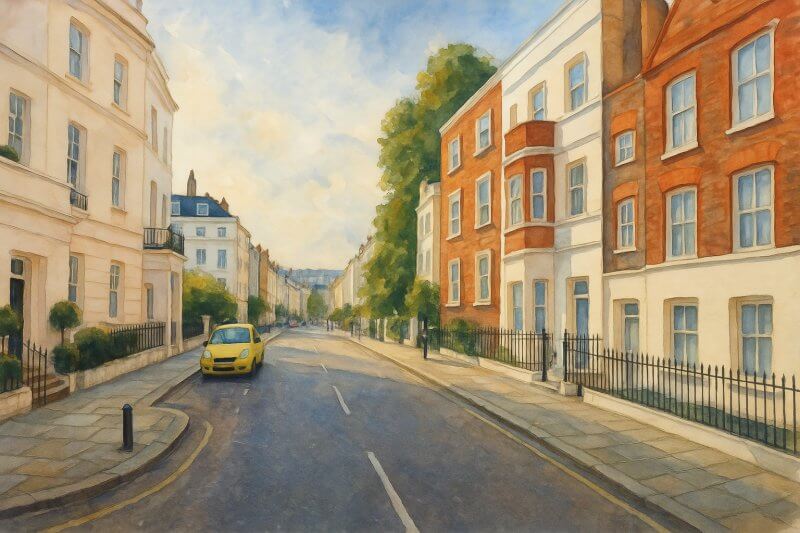
Belgravia: London's Elegant Neighbourhood of Prestige and Tranquillity
Where is Belgravia?
Belgravia is a distinguished residential district in Central London, straddling two boroughs: the City of Westminster and the Royal Borough of Kensington and Chelsea.It lies just southwest of Buckingham Palace and is bordered by Knightsbridge to the north, Chelsea to the west, Pimlico to the south, and Victoria to the east. Its central location offers a peaceful yet prestigious retreat within the bustling heart of the city.
Size and Demographics
Belgravia is a relatively compact area, covering about 0.61 square kilometres (0.24 square miles). Despite its small size, it is one of the most exclusive neighbourhoods in London.As of recent estimates, Belgravia is home to approximately 10,000 residents, though the population can fluctuate due to the high number of foreign embassies, luxury hotels, and part-time residences.
Map of Belgravia, London
History and Development
The area now known as Belgravia was largely rural until the early 19th century. It formed part of the vast Grosvenor family estate, which also included Mayfair. The transformation of Belgravia into an elegant residential district began in the 1820s under the vision of Richard Grosvenor, 2nd Marquess of Westminster, and the architectural direction of Thomas Cubitt, one of London's most celebrated master builders.Cubitt designed a neighbourhood filled with elegant stucco-fronted terraces, harmonious squares, and leafy crescents - an architectural style that remains synonymous with Belgravia to this day. The area quickly became one of the most fashionable residential districts for the aristocracy and upper classes in Victorian London.
Origin of the Name "Belgravia"
Belgravia takes its name from Belgrave, a village located on the Grosvenor family's estate in Cheshire, near the city of Chester. The name "Belgravia" was first used in the 1820s during the development of the area and served to reflect the Grosvenors' country roots while branding their new residential quarter in London with a sense of noble charm. The term "Belgravia" has since become synonymous with quiet opulence and understated prestige.Major Roads in Belgravia
Belgravia is graced by several notable roads, many of which are lined with white stucco-fronted Georgian and Regency-style houses. Key roads include:- Belgrave Square: One of the grandest squares in London, lined with embassies and stately homes.
- Eaton Square: An elongated garden square considered one of the most desirable residential addresses in the capital.
- Chesham Place: Home to several embassies and distinguished buildings.
- Elizabeth Street: A charming high street filled with boutiques, cafes, and flower shops.
- Ebury Street: Known for its elegant houses and connections to historical figures like Mozart.

Painting of Belgravia (View full-size image here)
Major Buildings and Sights
Though primarily residential, Belgravia contains several buildings and landmarks of note:- Belgrave Square: Surrounded by embassies including those of Spain, Germany, and Norway, and featuring a central private garden.
- Eaton Square: One of the largest and most elegant garden squares in London.
- The Lanesborough Hotel: A luxury hotel located on Hyde Park Corner, on the northern fringe of Belgravia.
- St Peter's Church: A neoclassical Anglican church on Eaton Square, completed in 1827.
- Mozart's London Home: A blue plaque at 180 Ebury Street commemorates the young Wolfgang Amadeus Mozart, who lived here briefly in 1764.
- Elizabeth Street: A picturesque shopping street known for independent boutiques and Peggy Porschen's famous pink cake shop.
Nearest London Underground Stations
Belgravia is exceptionally well-connected by public transport, with several London Underground stations located just a short walk away:- Victoria Station: Served by the Victoria, Circle, and District lines, as well as National Rail and coach services.
- Hyde Park Corner: Served by the Piccadilly line.
- Sloane Square: Served by the Circle and District lines, offering access to King's Road and Chelsea.
- Knightsbridge: Served by the Piccadilly line, ideal for reaching Harrods and Hyde Park.
Fun Facts About Belgravia
Belgravia has a few lesser-known but fascinating tidbits:- Ian Fleming, the creator of James Bond, lived at 22 Ebury Street during the 1930s.
- The streets of Belgravia frequently appear in television and film. The area has featured in series like "Downton Abbey" and "The Crown" due to its authentic period look.
- Belgravia has a reputation for being quiet - even eerily so at times. Many homes are owned by international residents who are rarely in town, making some streets feel almost deserted despite being in central London.
- The fictional home of "Sherlock Holmes's brother, Mycroft Holmes", is sometimes cited as being in Belgravia, especially in modern adaptations like "Sherlock" (BBC).
A Neighbourhood of Enduring Elegance
Belgravia remains one of London's most prestigious districts, embodying the classic charm and architectural grace of 19th-century urban planning. Though exclusive, its beautifully maintained streets, historic buildings, and proximity to major landmarks make it a place of interest not only to residents but also to curious visitors.Whether strolling down Elizabeth Street, admiring the embassies around Belgrave Square, or simply soaking in the peaceful grandeur of its white terraces, Belgravia offers a unique and refined glimpse into London's aristocratic heritage.